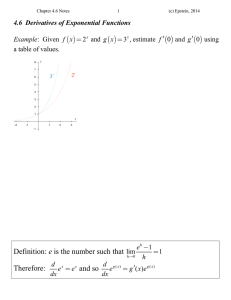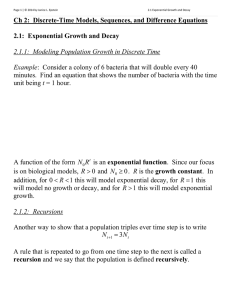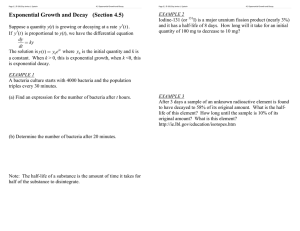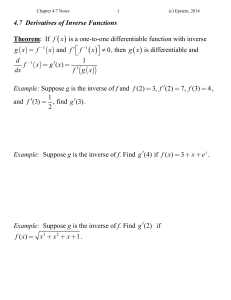1.2 Elementary Functions D =
advertisement
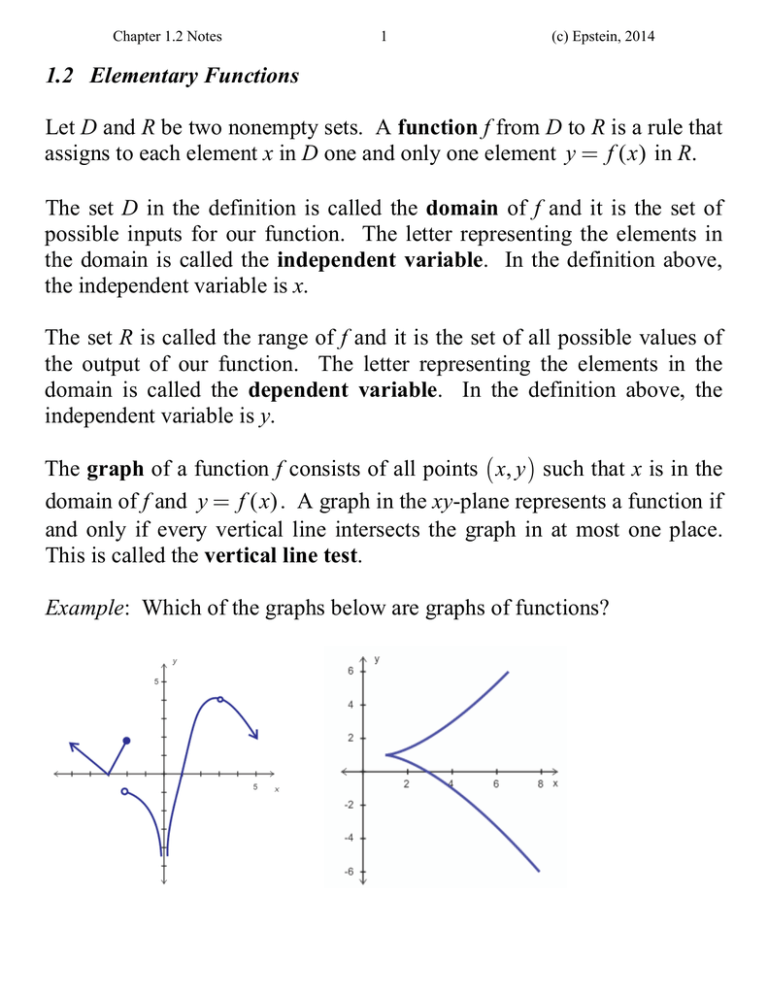
Chapter 1.2 Notes 1 (c) Epstein, 2014 1.2 Elementary Functions Let D and R be two nonempty sets. A function f from D to R is a rule that assigns to each element x in D one and only one element y = f ( x) in R. The set D in the definition is called the domain of f and it is the set of possible inputs for our function. The letter representing the elements in the domain is called the independent variable. In the definition above, the independent variable is x. The set R is called the range of f and it is the set of all possible values of the output of our function. The letter representing the elements in the domain is called the dependent variable. In the definition above, the independent variable is y. The graph of a function f consists of all points ( x, y ) such that x is in the domain of f and y = f ( x) . A graph in the xy-plane represents a function if and only if every vertical line intersects the graph in at most one place. This is called the vertical line test. Example: Which of the graphs below are graphs of functions? Chapter 1.2 Notes 2 (c) Epstein, 2014 A polynomial is a function of the form f ( x) = a0 + a1 x + a2 x 2 + + an x n where n is a non-negative integer and ai are real valued constants. The leading coefficient is an and an ¹ 0 . The degree of the polynomial is n. The domain of a polynomial is  or , . Some common polynomials degree 0: y = 2.5 constant function degree 1: y = 2 x - 3 linear function degree 2: y = x 3 - 2 x 2 quadratic function degree 3: y = -x 2 + 3 x + 4 cubic function A rational function f ( x ) is the quotient of two polynomial functions p ( x ) p ( x) and q ( x ): f ( x ) = q ( x) The domain of f ( x) is all real numbers for which q ( x ) ¹ 0 Example: What is the domain of f ( x) = x +1 ? 2 x -1 Chapter 1.2 Notes 3 (c) Epstein, 2014 A function of the form f ( x ) = x r where r is a real number is called a power function. Some examples of power functions: 1 y = x -1 y=x 2 Example: In the case of f ( x ) = n x what is the domain? f ( x ) = a x , a > 0, a ¹ 1 is called an exponential function. Exponential functions are often used to model growth and decay. If A0 is the initial amount and k is the growth or decay rate, then the population at time t is given by A(t ) = A0e kt For exponential growth, k > 0 and for exponential decay, k < 0 . Example: A bacteria culture starts with 4000 bacteria and the population triples every 30 minutes. Find an expression for the number of bacteria after t hours. Chapter 1.2 Notes 4 (c) Epstein, 2014 The half-life of a substance is the amount of time it takes for half of the substance to disintegrate. Example: After 3 days a sample of an unknown radioactive element is found to have decayed to 58% of its original amount. What is the half-life of this element? http://ie.lbl.gov/education/isotopes.htm A function f ( x )is one-to-one provided that whenever f ( x1 ) = f ( x2 ) then x1 = x2. One way to check if a function is one-to-one is to use the horizontal line test. Let f(x) be a one-to-one function with domain D and range R. Then the inverse function f -1 ( x ) exists. The domain of f -1 ( x ) is R and the range of f -1 ( x )is D. Moreover, f ( x) = y f -1 ( y ) = x Example: Find the inverse, and the domain and range of f x 5 4 x 3 . Chapter 1.2 Notes 5 (c) Epstein, 2014 The inverse of the exponential function f x a x is f 1 x log a x . Example: Find the domains and ranges of f x a x and f 1 x log a x x y e x and y ln x 1 y and y log 1 2 x 2 Example: Find the domain and range of each function f ( x) = log ( x 2 - 3x + 2) g ( x) = ln ( x3 - x) Example: Write the expressions 5 x and log 7 x 5 in terms of base e. Chapter 1.2 Notes 6 (c) Epstein, 2014 f ( x) is a periodic function if there is a positive constant c such that f x p f x . If p is the smallest number with this property, we call it the period of f ( x) . The trigonometric functions are periodic functions. sin(x) 1 -p p 2p 3p p 2p 3p -1 cos(x) 1 -p -1 For any real number a and k 0 , the functions f x a sin kx and 2 . g x a cos kx have an amplitude of a and a period of p k Example: Find the amplitude and period of f x 3sin 2 x and graph the function. Chapter 1.2 Notes 7 (c) Epstein, 2014

